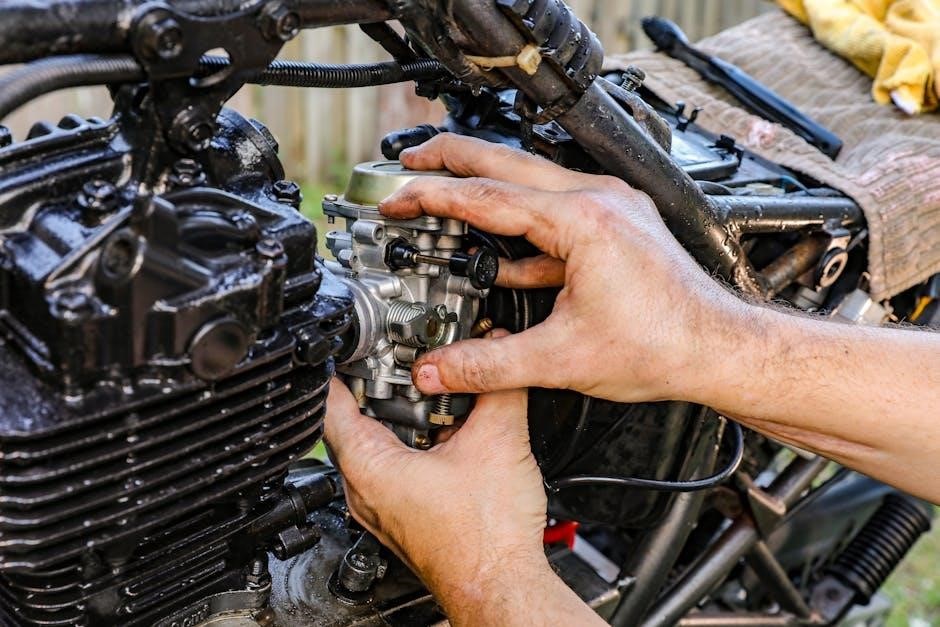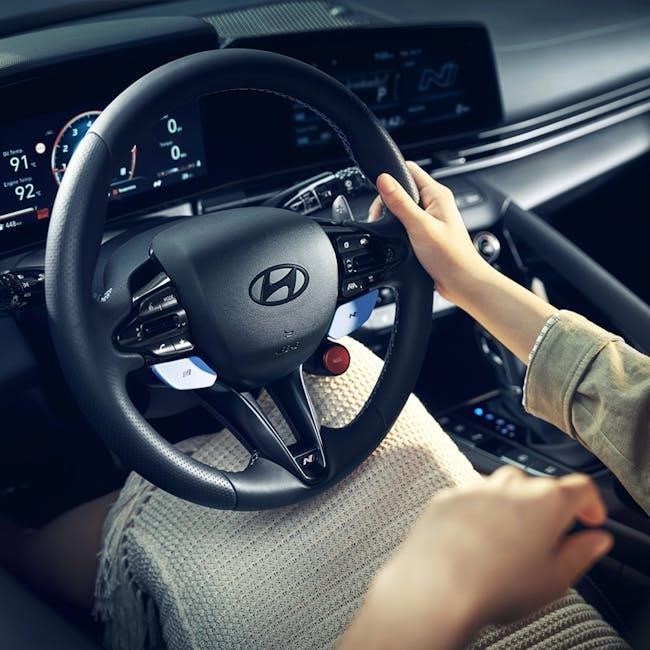The debate between automatic and manual motorcycles sparks discussion among riders‚ focusing on transmission types‚ ease of use‚ and control‚ catering to different riding styles and preferences.
Overview of Motorcycle Transmission Types
Motorcycles primarily feature two transmission types: automatic and manual. Automatic transmissions‚ including Continuously Variable Transmissions (CVT) and Dual Clutch Transmissions (DCT)‚ shift gears without rider input‚ offering ease of use. Manual transmissions require riders to operate a clutch and gearshift‚ providing control over gear changes. Semi-automatic transmissions also exist‚ combining elements of both systems. Each type catersto different riding preferences‚ whether prioritizing convenience‚ fuel efficiency‚ or hands-on engagement. Understanding these mechanisms helps riders choose the best option for their lifestyle and skill level‚ ensuring a smoother and more enjoyable riding experience.
Importance of Choosing the Right Transmission
Selecting the right motorcycle transmission is crucial for optimal performance‚ fuel efficiency‚ and rider comfort. Automatic transmissions simplify urban commuting‚ reducing fatigue in heavy traffic‚ while manuals offer better control and engagement on open roads; For beginners‚ automatics minimize the learning curve‚ enhancing safety. Experienced riders might prefer manuals for precision and connection with the bike. Fuel efficiency varies‚ with manuals often edging out automatics. Maintenance costs differ too‚ as manuals typically require less complex repairs. Ultimately‚ the choice hinges on lifestyle‚ riding conditions‚ and personal preference‚ ensuring a tailored experience that maximizes enjoyment and practicality for each rider.

What Are Automatic Motorcycles?
Automatic motorcycles feature transmissions that shift gears without manual intervention‚ offering ease of use and smooth acceleration‚ ideal for urban commuting and new riders seeking simplicity.
How Automatic Transmissions Work
Automatic motorcycles rely on a continuously variable transmission (CVT) or dual-clutch systems‚ eliminating manual gear shifting. Sensors detect speed and torque‚ automatically adjusting gears for seamless power delivery without rider input‚ enhancing low-speed maneuverability and reducing fatigue in traffic. This technology optimizes performance across various riding conditions‚ making it accessible for new riders while maintaining efficiency and smooth acceleration; The system ensures the engine operates within its optimal power range‚ providing a hassle-free riding experience. This design minimizes the learning curve‚ allowing riders to focus on braking and steering‚ making automatic motorcycles a popular choice for urban and casual riders.
Advantages of Automatic Motorcycles
Automatic motorcycles offer unparalleled convenience and ease of use‚ making them ideal for new riders and urban commutes. They eliminate the need for manual gear shifting‚ reducing driver fatigue and allowing riders to focus on braking and steering. This simplicity lowers the learning curve‚ making automatics a great choice for beginners. Additionally‚ automatics provide smooth acceleration and seamless power delivery‚ enhancing the riding experience in traffic-heavy areas. They also tend to be more fuel-efficient in low-speed conditions‚ further boosting their practicality for daily use. Overall‚ automatic motorcycles combine accessibility‚ comfort‚ and efficiency‚ catering to riders who prioritize ease and convenience.
Popular Models of Automatic Motorcycles
The market offers a variety of automatic motorcycles‚ catering to diverse preferences and needs. One standout model is the Honda PCX‚ known for its sleek design and impressive fuel efficiency‚ making it a top choice for urban commuting. Another popular option is the Yamaha SMAX‚ which combines agility with a powerful engine‚ ideal for navigating city streets. The Suzuki Burgman series also stands out‚ offering a comfortable ride and ample storage space‚ perfect for longer trips. These models exemplify the practicality and convenience of automatic motorcycles‚ appealing to both new and experienced riders seeking hassle-free performance. Their popularity underscores the growing demand for automatic transmissions in modern motorcycling.

What Are Manual Motorcycles?
Manual motorcycles require a clutch and gear shifting‚ offering riders more control and engagement‚ appealing to experienced riders seeking a hands-on riding experience.
How Manual Transmissions Work
A manual motorcycle transmission requires the rider to actively engage and disengage gears using a clutch lever and a foot shifter. The process involves pulling the clutch lever‚ shifting gears‚ and gradually releasing the clutch while applying the throttle for smooth acceleration. This system provides direct control over power delivery‚ allowing riders to optimize speed and torque based on driving conditions. Manual transmissions often require more skill and practice to master‚ as improper clutch control can lead to stalling or jerky movements. Despite the learning curve‚ manual transmissions are praised for their precision and efficiency‚ making them a preferred choice for experienced riders seeking a more hands-on experience.
Advantages of Manual Motorcycles
Manual motorcycles offer several advantages‚ including better fuel efficiency‚ enhanced control‚ and lower purchase costs. The ability to manually shift gears allows riders to optimize engine performance‚ leading to improved mileage in various driving conditions. Additionally‚ manual transmissions are generally lighter and less complex than automatics‚ reducing overall weight and increasing agility. The direct connection between the rider and the bike fosters a more immersive riding experience. Furthermore‚ manual motorcycles often require less maintenance and have lower repair costs over time. These factors make manual motorcycles a popular choice among experienced riders who value precision‚ cost-effectiveness‚ and a deeper connection to their vehicle.
Popular Models of Manual Motorcycles
Several manual motorcycles stand out for their performance‚ reliability‚ and popularity among riders. The Honda CB300F is a lightweight‚ fuel-efficient option ideal for both commuters and new riders. The Yamaha MT-07 is celebrated for its agility and affordable price point‚ making it a favorite among enthusiasts. Meanwhile‚ the Kawasaki Ninja 400 combines sporty styling with a smooth manual transmission‚ appealing to riders seeking a balance of power and control. These models exemplify the best of manual motorcycles‚ offering riders a blend of tradition‚ precision‚ and enjoyment on the road. They remain top choices for those who prefer the hands-on experience of shifting gears.

Key Differences Between Automatic and Manual Motorcycles
Automatic motorcycles simplify riding with no manual shifting‚ while manual models offer better control and fuel efficiency‚ making them preferred for experienced riders seeking precision and performance.
Differences in Fuel Efficiency
Manual motorcycles generally offer better fuel efficiency compared to automatic models due to the rider’s ability to optimize gear shifts. Automatics‚ while convenient‚ may consume slightly more fuel‚ especially in heavy traffic or frequent stop-and-go scenarios. This difference‚ however‚ is not always significant and can vary depending on the specific model and riding style. For budget-conscious riders‚ manual transmissions often provide a slight edge in fuel economy.
Differences in Maintenance and Repair
Manual motorcycles typically require more maintenance due to the complexity of their transmission systems‚ including the clutch and gear components. Riders must regularly inspect and replace worn parts like clutch plates and gear bearings‚ which can increase maintenance costs over time. Automatic motorcycles‚ while simpler in design‚ may still require periodic fluid changes and adjustments to the belt or CVT system. However‚ automatics generally have fewer moving parts‚ reducing the likelihood of mechanical failures compared to manual transmissions. Overall‚ manual bikes may incur higher maintenance costs‚ while automatics offer a more straightforward and potentially lower-maintenance ownership experience.
Differences in Learning Curve for Riders
The learning curve for automatic and manual motorcycles varies significantly. Automatic motorcycles are generally easier to learn on‚ as they eliminate the need to manually shift gears or use a clutch‚ reducing the complexity for new riders. This simplicity allows beginners to focus on balancing‚ braking‚ and throttle control without the added stress of gear changes. Manual motorcycles‚ however‚ require coordination between the clutch and throttle‚ which can be challenging for novices; Riders must practice shifting gears smoothly and feathering the clutch to avoid stalling‚ making the initial learning process more daunting. This makes automatic motorcycles more accessible for first-time riders.

Which Type of Motorcycle is Better for Beginners?
Automatic motorcycles are generally recommended for beginners due to their simplicity and ease of operation‚ allowing new riders to focus on basic control skills without the complexity of manual gear shifting.
Ease of Use and Safety for New Riders
Automatic motorcycles are highly recommended for new riders due to their simplicity and reduced complexity. With no manual shifting required‚ riders can focus on balance‚ braking‚ and steering‚ reducing the learning curve. Automatics eliminate the risk of stalling‚ a common issue with manual bikes‚ especially in stop-and-go traffic. This ease of operation allows beginners to build confidence and improve their riding skills without the added stress of clutch control. Safety is enhanced as riders can keep both hands on the handlebars and react quickly to unexpected situations. For inexperienced riders‚ automatic motorcycles provide a more forgiving and less intimidating introduction to motorcycling‚ making them an ideal choice for learning the basics of safe riding.
Recommendations for First-Time Motorcycle Buyers
First-time motorcycle buyers should prioritize ease of handling and safety. Automatic motorcycles are ideal for novices‚ as they simplify the riding experience by eliminating manual shifting. This allows new riders to focus on fundamental skills like braking and balance without the added complexity of clutch operation. Additionally‚ automatics reduce the risk of stalling‚ which is common when learning to ride. For those interested in manual transmissions‚ consider starting with a bike that has a forgiving clutch and low seat height. Ultimately‚ the choice should align with the rider’s comfort level and intended use‚ ensuring a positive and safe introduction to motorcycling.
Future Trends in Motorcycle Transmissions
Advancements in automatic transmissions‚ such as dual-clutch systems‚ are gaining traction‚ offering smoother shifts and improved performance. Manual transmissions are also evolving with clutchless designs‚ blending tradition with innovation.
Technological Advancements in Automatic Transmissions
Automatic motorcycle transmissions are evolving rapidly‚ with advancements like dual-clutch technology offering smoother shifts and improved fuel efficiency. Companies like Honda have developed dual-clutch transmissions (DCT) over the past decade‚ enhancing performance and rider comfort. These systems provide seamless gear changes without manual intervention‚ catering to both novice and experienced riders. Future innovations may include smart shifting systems that adapt to riding styles and integrate with other bike technologies‚ such as ride-by-wire and adaptive cruise control. Automatic transmissions are becoming more refined‚ bridging the gap with manual bikes in terms of control and efficiency.
Evolution of Manual Transmissions
Manual motorcycle transmissions have undergone significant advancements over the years‚ refining their design for better performance and rider experience. Early manual systems were basic‚ with fewer gears and less sophisticated clutch mechanisms. Modern manual transmissions now feature lightweight materials‚ smoother gear engagement‚ and improved durability. Innovations like quick-shifters and slipper clutches enhance control during aggressive riding. While automatics gain popularity‚ manual transmissions remain a preferred choice for many due to their tactile feedback and ability to optimize power delivery. Despite competition from automatics‚ manual transmissions continue to evolve‚ maintaining their relevance in the motorcycle industry.
The choice between automatic and manual motorcycles ultimately depends on personal preference‚ riding style‚ and experience‚ with each offering unique benefits tailored to different needs and lifestyles.
Final Thoughts on Choosing the Right Motorcycle
The decision between automatic and manual motorcycles hinges on personal preference‚ lifestyle‚ and riding goals. Automatics offer ease and convenience‚ ideal for urban commutes and newcomers‚ while manuals provide tactile control and potential fuel efficiency‚ appealing to experienced riders. Consider factors like daily usage‚ terrain‚ and desired engagement. Both types excel in their niches‚ so test-riding each can clarify which suits you best. Ultimately‚ the right motorcycle is one that aligns with your skills‚ comfort‚ and aspirations‚ ensuring an enjoyable and safe riding experience.
